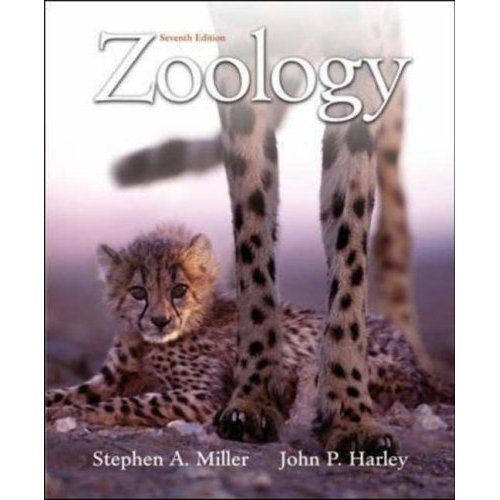Zoology, 7th edition
Zoology, 7th edition
by Stephen A Miller (Author), John P Harley (Author)
$58.18
Compare At: $112.81

Money Back
Love it! Use it! Reuse it!

Free Shipping
Shipping is on us

Free Support
24/24 available
Description
The new 7th edition of Zoology continues to offer students an introductory general zoology text that is manageable in size and adaptable to a variety of course formats. It is a principles-oriented text written for the non-majors or the combined course, presented at the freshman and sophomore level.
Zoology is organized into three parts. Part One covers the common life processes, including cell and tissue structure and function, the genetic basis of evolution, and the evolutionary and ecological principles that unify all life. Part Two is the survey of protists and animals, emphasizing evolutionary and ecological relationships, aspects of animal organization that unite major animal phyla, and animal adaptations. Part Three covers animal form and function using a comparative approach. This approach includes descriptions and full-color artwork that depict evolutionary changes in the structure and function of selected organ systems.
Table of Contents
Part One Biological Principles
1 Zoology: An Ecological and Evolutionary Perspective
2 Cells, Tissues, Organs, and Organ Systems of Animals
3 Cell Division and Inheritance
4 Evolution: History and Evidence
5 Evolution and Gene Frequencies
6 Ecology: Preserving the Animal Kingdom
Part Two Animal-Like Protists and Animalia
7 Animal Classification, Phylogeny, and Organization
8 Animal-like Protists: The Protozoa
9 Multicellular and Tissue Levels of Organization
10 The Triploblastic, Acoelomate Body Plan
11 The Pseudocoelomate Body Plan: Aschelminths
12 Molluscan Success
13 Annelida: The Metameric Body Form
14 The Arthropods: Blueprint for Success
15 The Hexapods and Myriapods: Terrestrial Triumphs
16 The Echinoderms
17 Hemichordata and Invertebrate Chordates
18 The Fishes: Vertebrate Success in Water
19 Amphibians: The First Terrestrial Vertebrates
20 Reptiles: The First Amniotes
21 Birds: Reptiles by Another Name
22 Mammals: Specialized Teeth, Hair Endothermy, and Viviparity
Part Three Form and Function: A Comparative Perspective
23 Protection, Support, and Movement
24 Communication I: Nervous and Sensory Systems
25 Communication II: The Endocrine System and Chemical Messengers
26 Circulation and Gas Exchange
27 Nutrition and Digestion
28 Temperature and Body Fluid Regulation
29 Reproduction and Development
30 The Chemical Basis of Animal Life
31 Energy and Enzymes: Life's Driving and Controlling Forces
32 How Animals Harvest Energy Stored in Nutrients
33 Embryology
34 Animal Behavior
About the Author
Stephen Miller currently teaches courses in Zoology, Biology and Invertebrate Zoology at The College of the Ozarks, Lookout Point, MO (Branson). He is also the author of General Zoology Lab Manual, 3e. John Harley teaches Anatomy & Physiology and General Biology at Eastern Kentucky University, Richmond, KY and is also co-author of Prescott/Harley/Klein Microbiology and the ASM Microbial Telecourse Study Guide.
Table of Contents
Part One Biological Principles
1 Zoology: An Ecological and Evolutionary Perspective
2 Cells, Tissues, Organs, and Organ Systems of Animals
3 Cell Division and Inheritance
4 Evolution: History and Evidence
5 Evolution and Gene Frequencies
6 Ecology: Preserving the Animal Kingdom
Part Two Animal-Like Protists and Animalia
7 Animal Classification, Phylogeny, and Organization
8 Animal-like Protists: The Protozoa
9 Multicellular and Tissue Levels of Organization
10 The Triploblastic, Acoelomate Body Plan
11 The Pseudocoelomate Body Plan: Aschelminths
12 Molluscan Success
13 Annelida: The Metameric Body Form
14 The Arthropods: Blueprint for Success
15 The Hexapods and Myriapods: Terrestrial Triumphs
16 The Echinoderms
17 Hemichordata and Invertebrate Chordates
18 The Fishes: Vertebrate Success in Water
19 Amphibians: The First Terrestrial Vertebrates
20 Reptiles: The First Amniotes
21 Birds: Reptiles by Another Name
22 Mammals: Specialized Teeth, Hair Endothermy, and Viviparity
Part Three Form and Function: A Comparative Perspective
23 Protection, Support, and Movement
24 Communication I: Nervous and Sensory Systems
25 Communication II: The Endocrine System and Chemical Messengers
26 Circulation and Gas Exchange
27 Nutrition and Digestion
28 Temperature and Body Fluid Regulation
29 Reproduction and Development
30 The Chemical Basis of Animal Life
31 Energy and Enzymes: Life's Driving and Controlling Forces
32 How Animals Harvest Energy Stored in Nutrients
33 Embryology
34 Animal Behavior
About the Author
Stephen Miller currently teaches courses in Zoology, Biology and Invertebrate Zoology at The College of the Ozarks, Lookout Point, MO (Branson). He is also the author of General Zoology Lab Manual, 3e. John Harley teaches Anatomy & Physiology and General Biology at Eastern Kentucky University, Richmond, KY and is also co-author of Prescott/Harley/Klein Microbiology and the ASM Microbial Telecourse Study Guide.
Last updated on


